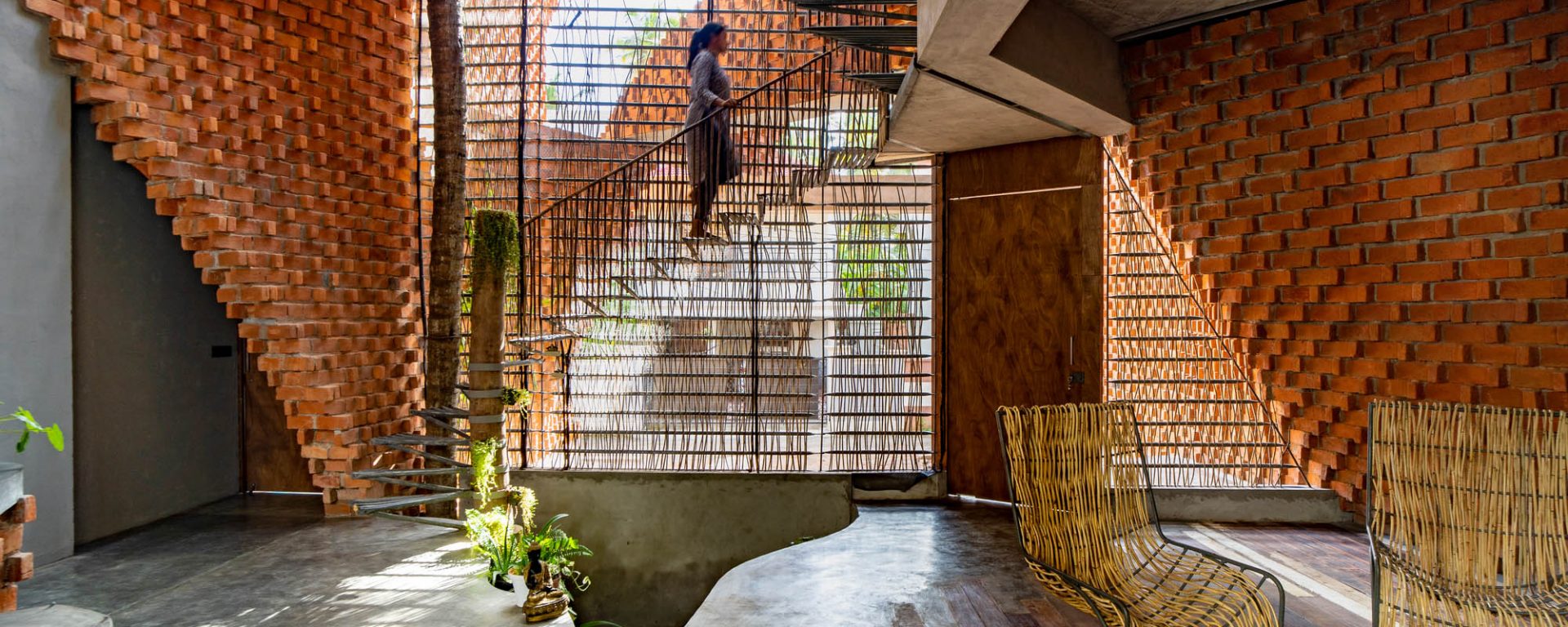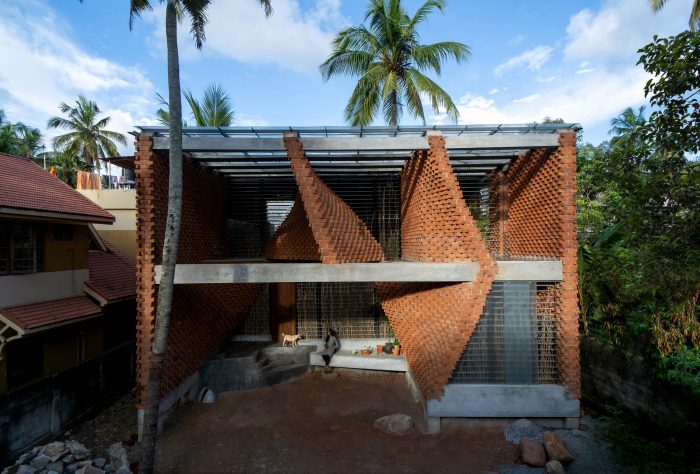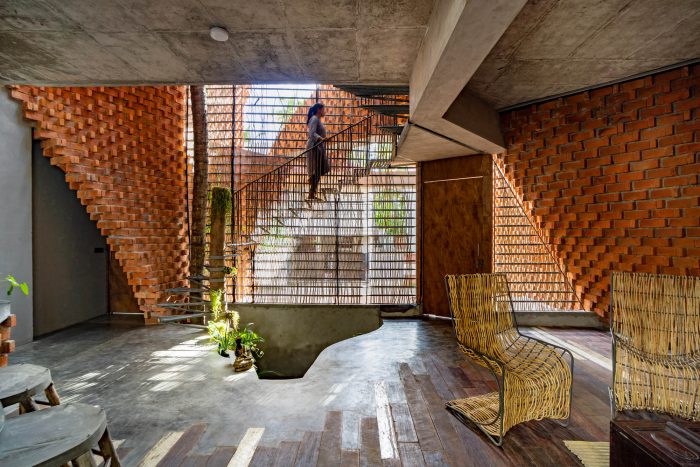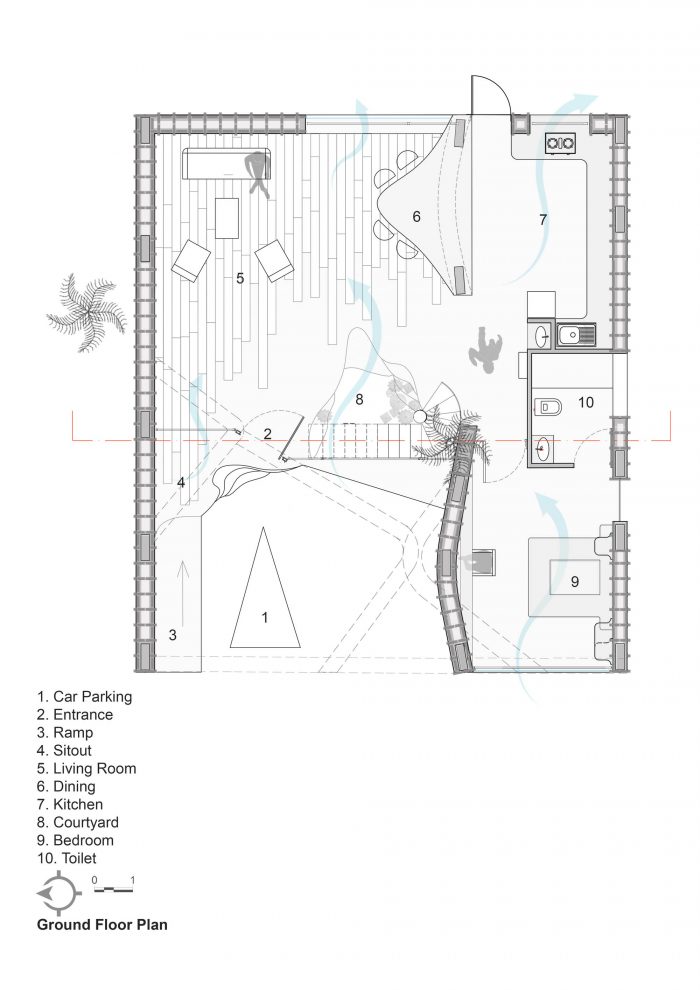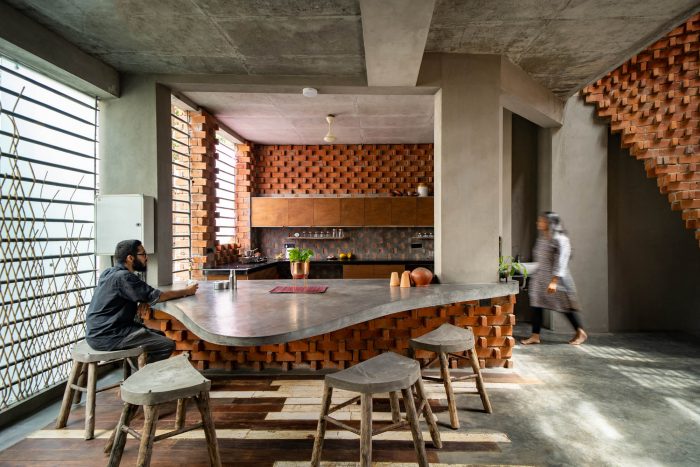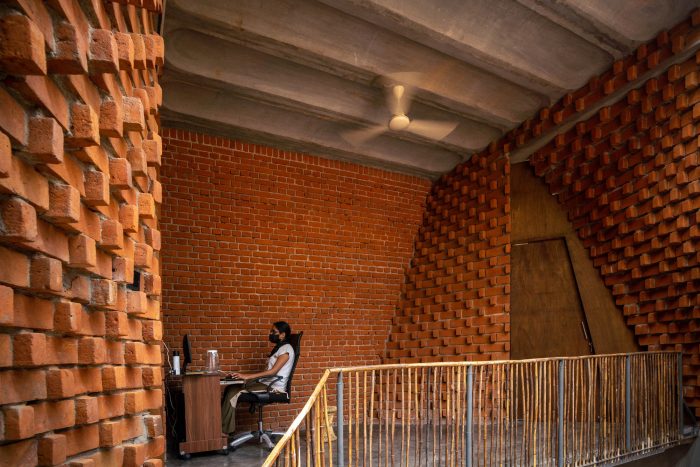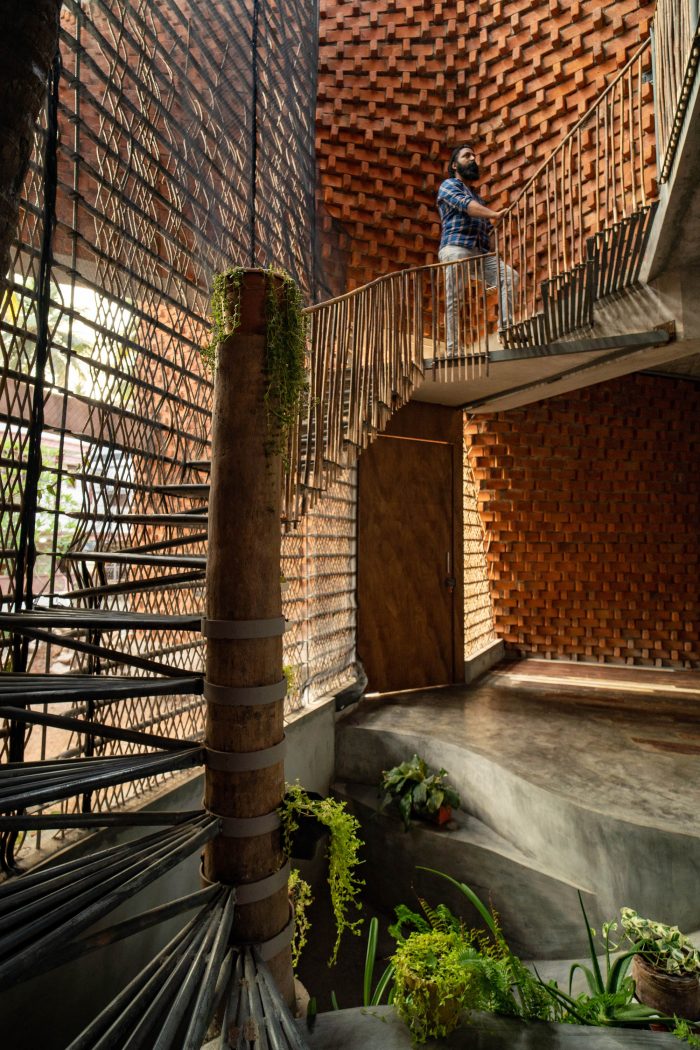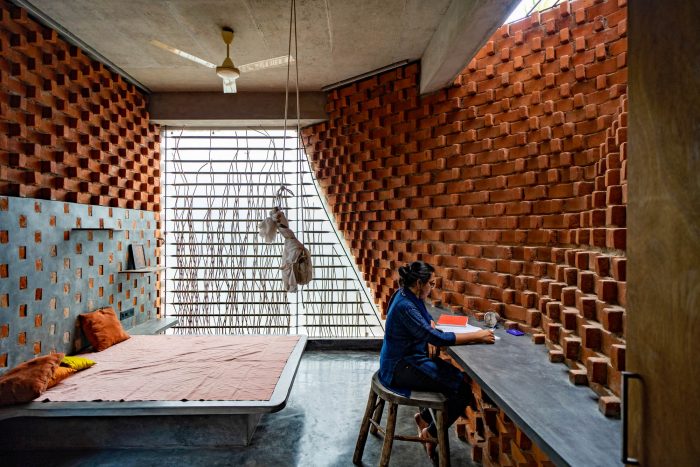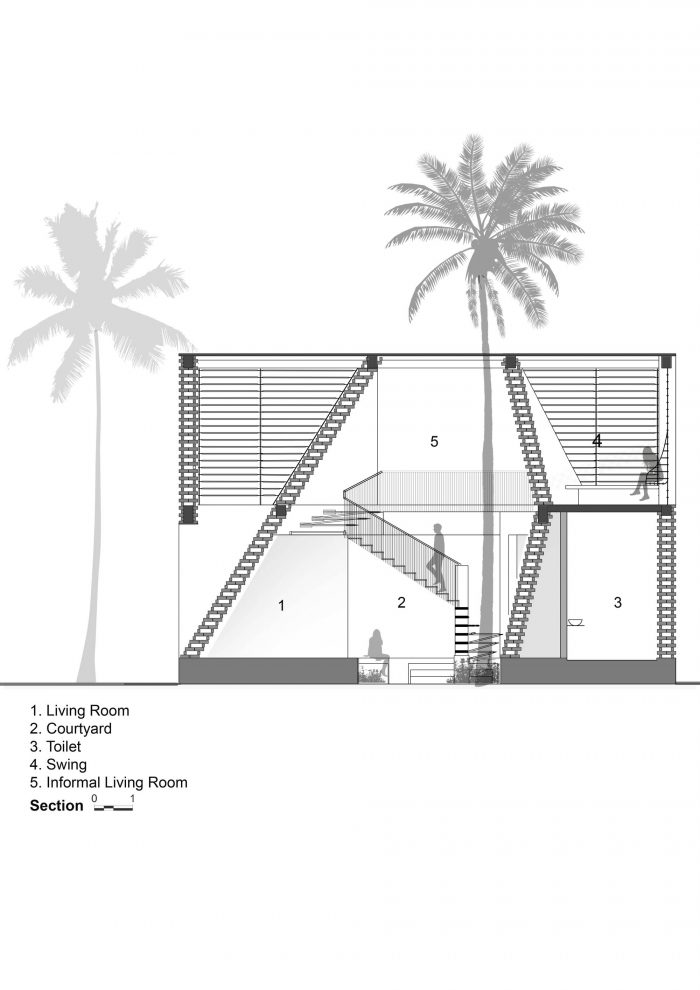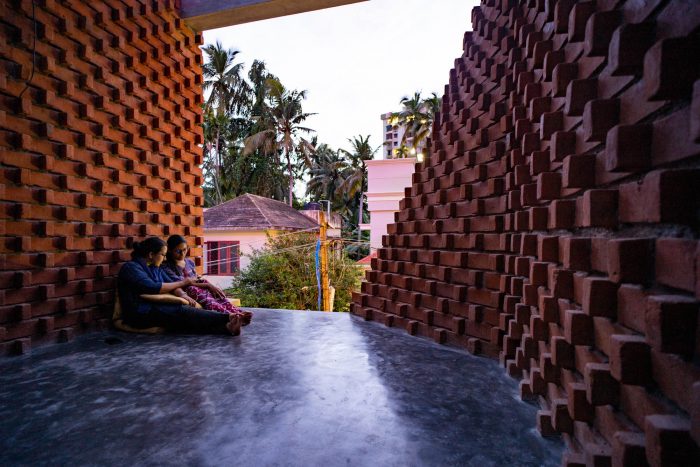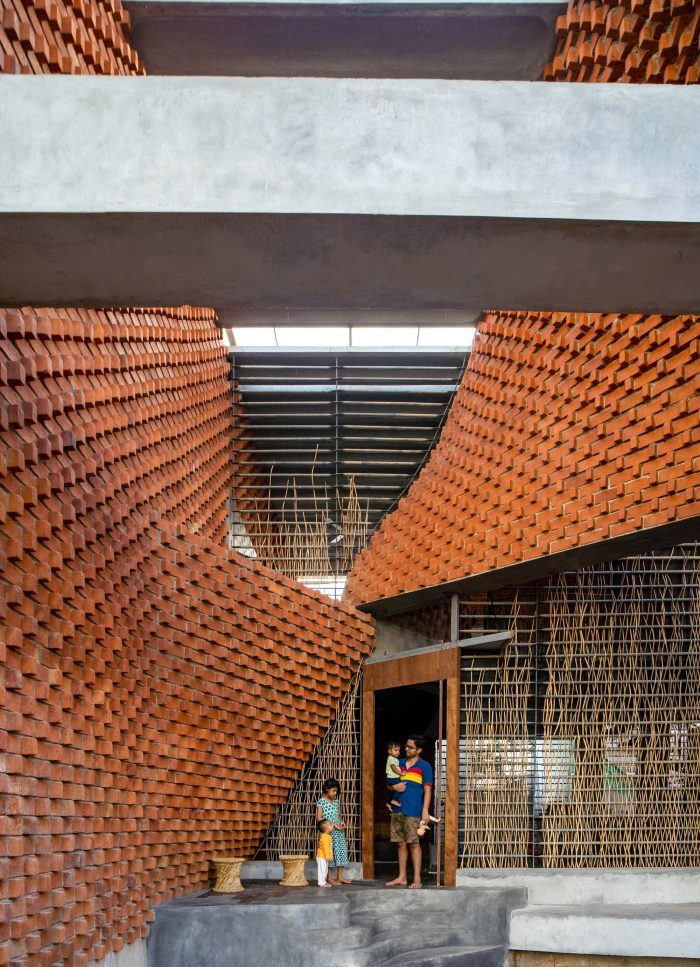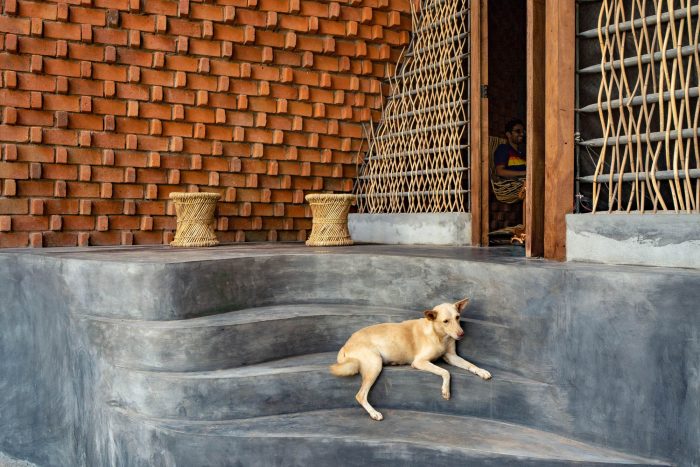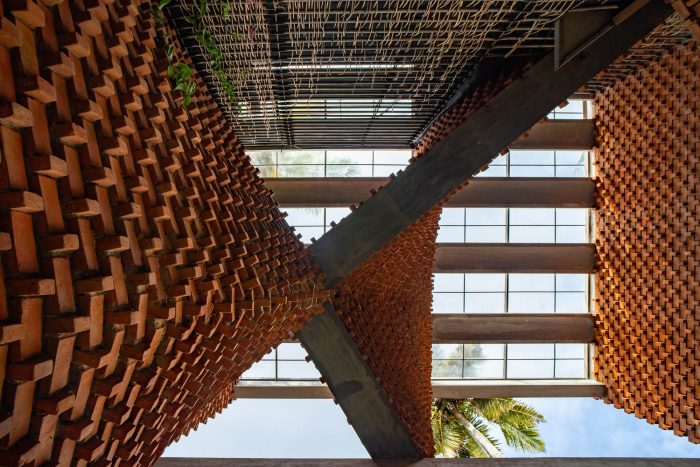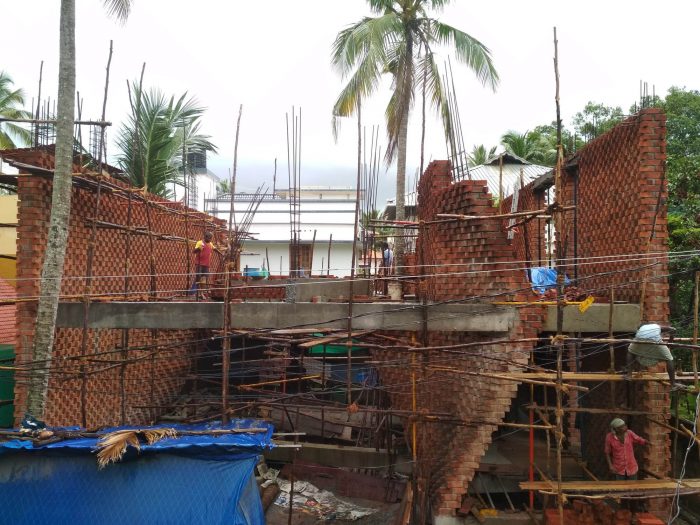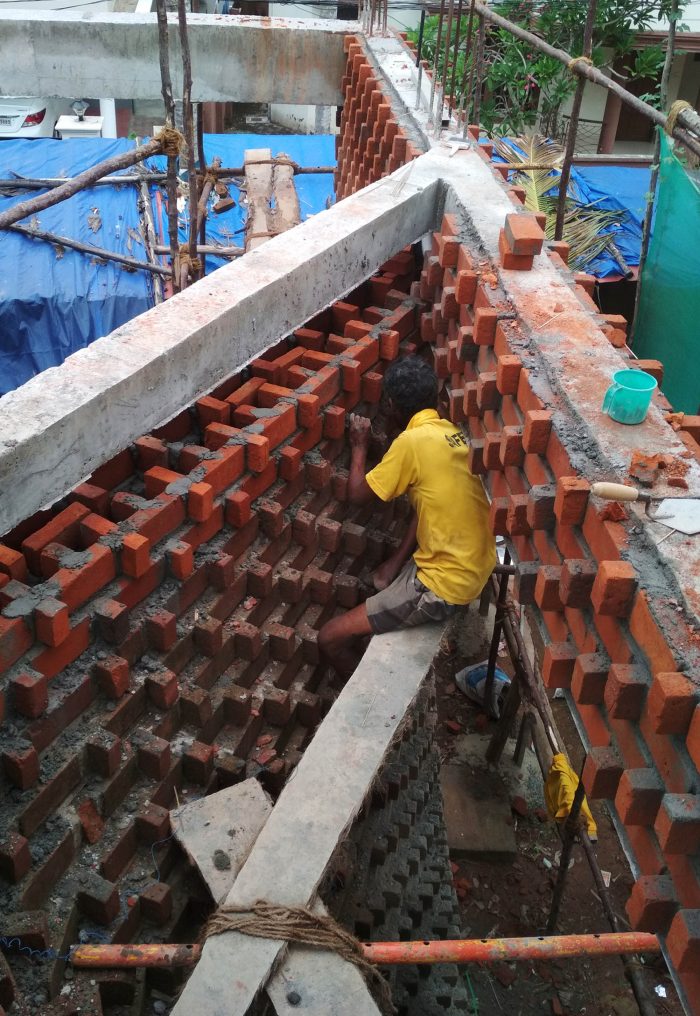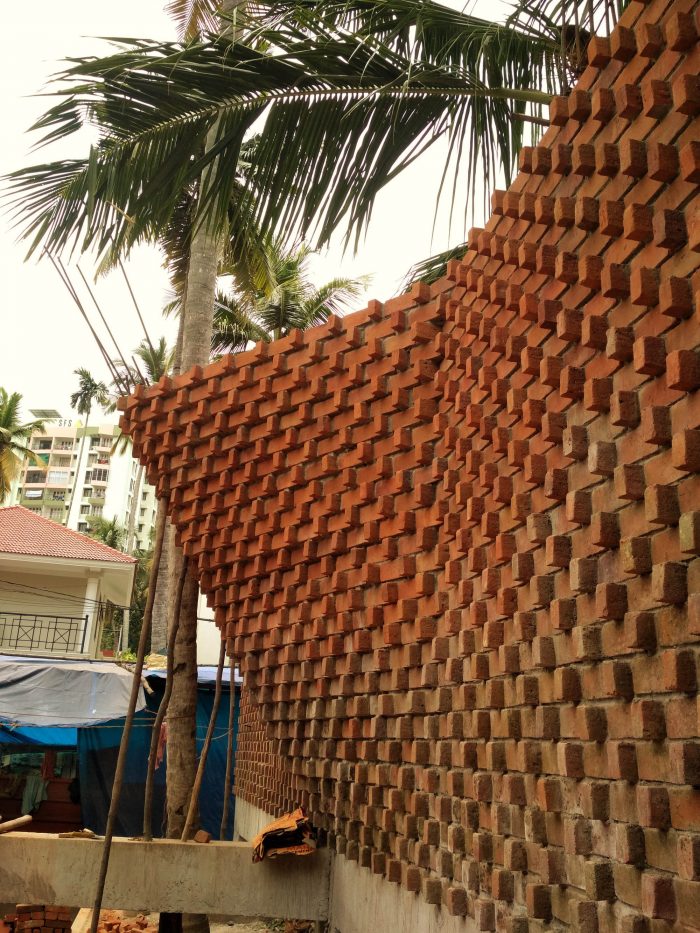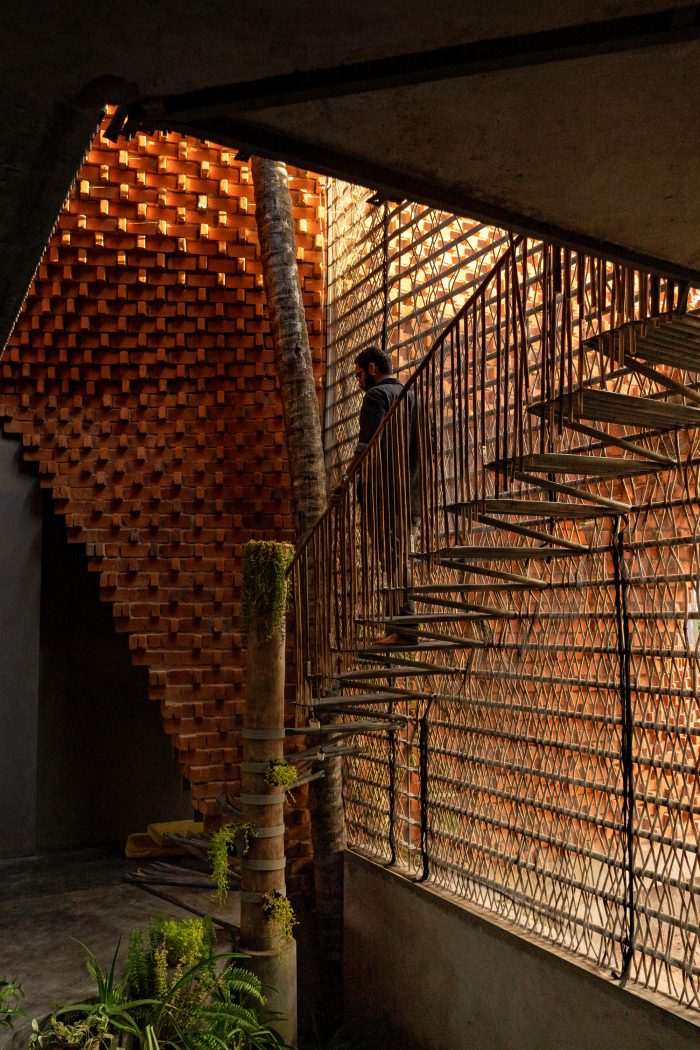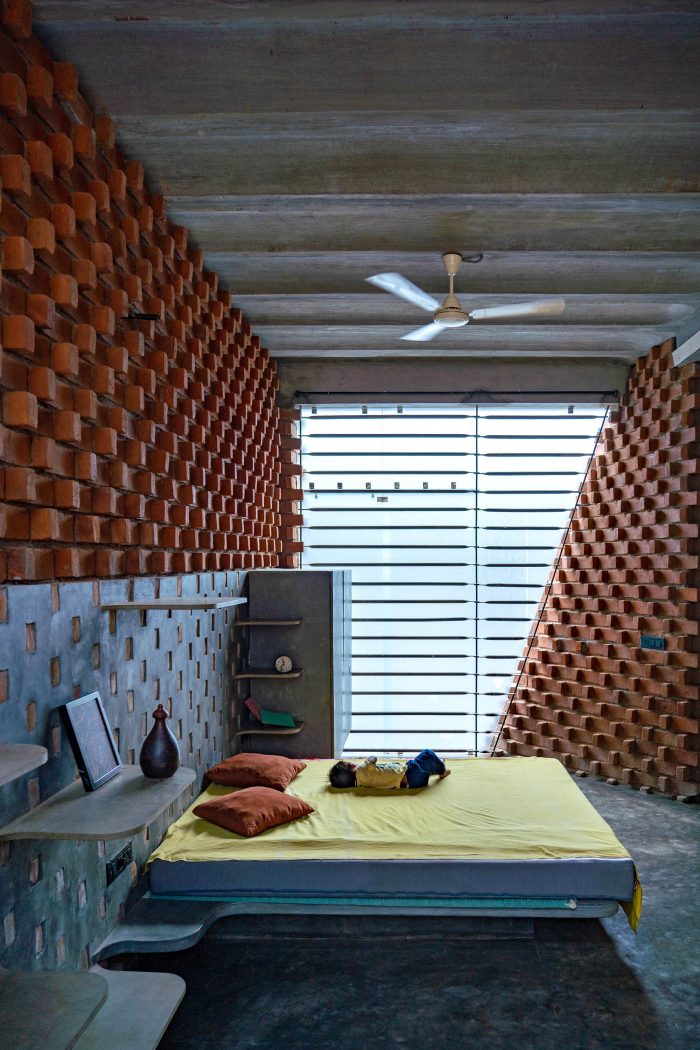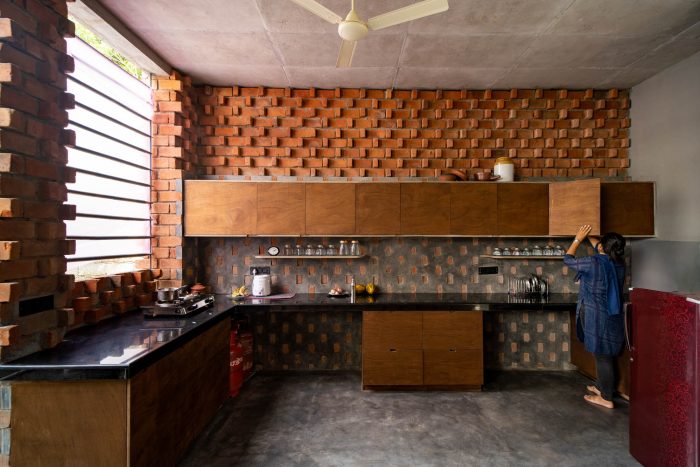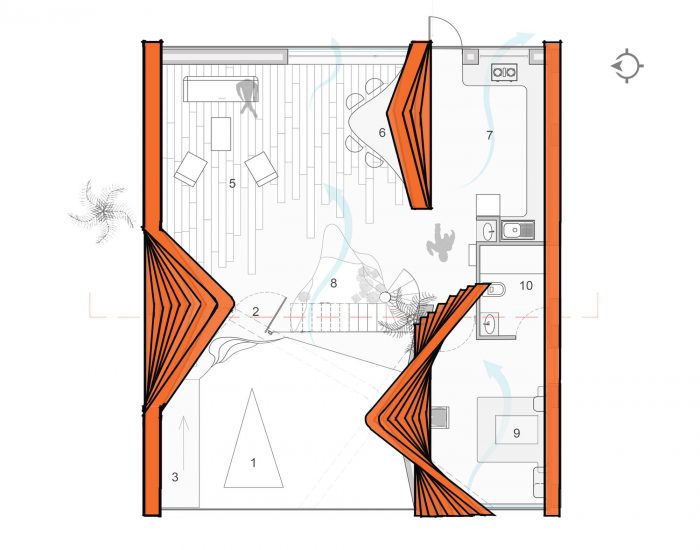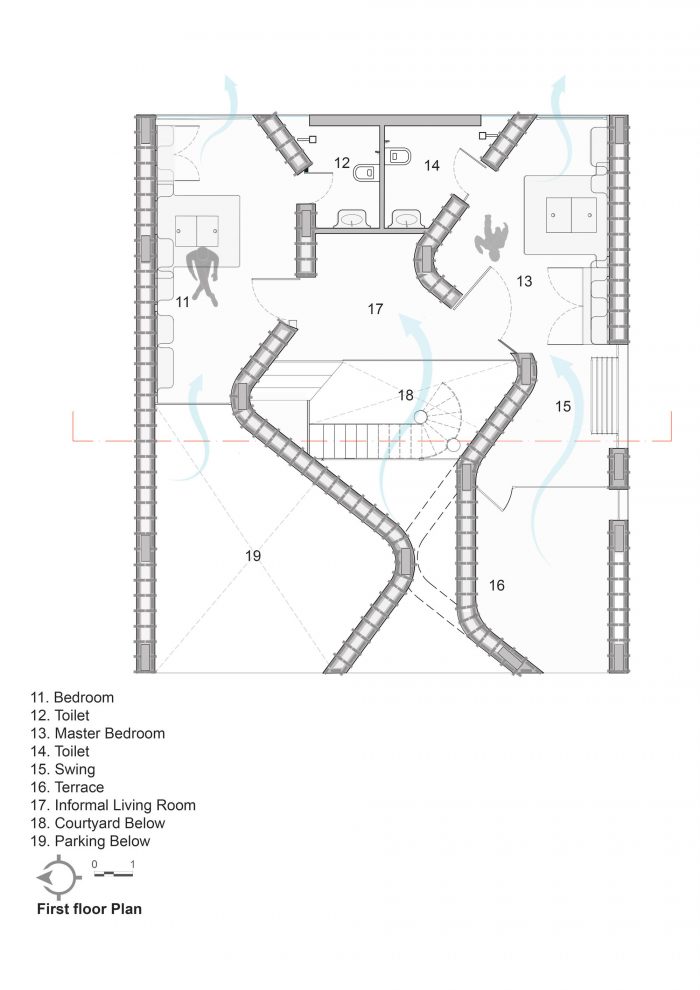该项目位于特里凡得琅市一个拥挤的城市中心,是一个被其他住宅项目从四面八方挤占的小地块。这个住宅的想法是有一个朝内的房子,所有的空间都向一个漏斗状的中央庭院开放。房子在东西方向上排列,开口有利于最大限度的交叉通风。
Located smack in the middle of an urban and crowded locale of Trivandrum, the site was a small plot that was being suffocated by other residential projects from all four sides. The idea of this residence was to have an inward facing house with all its spaces opening into a funneling central courtyard. The house is aligned in the East-West direction with openings facilitating for maximum cross-ventilation.
在特里凡得琅市的背景下,作为Ar.Laurie Baker的许多杰作的见证,似乎适合修改他自己的介绍之一,鼠笼式粘结砌筑技术在这个网站上没有提供土壤挖掘或制作泥块的机会。考虑到特里凡得琅的砖窑是一个濒临消失的行业,人们选择了线切割的机器砖,这也是为了推广这个濒临灭绝的当地农业产业。
In the context of the city of Trivandrum that stands as a testimonial to many of Ar.Laurie Baker’s masterpieces, it seemed fit to modify one of his own introductions, the Rat trap bond masonry technique in this site which didn’t offer the opportunity for soil excavation or for making mud blocks. Keeping in mind that Brick kilns in Trivandrum is a dying industry with people opting out for wire-cut machine made bricks, this was also an attempt to promote this local agriculture based industry that is on the brink of extinction.
捕鼠器粘结剂是一种砖砌筑墙体的方法,它将砖块放置在垂直位置,而不是传统的水平位置,从而在墙体内形成一个空腔,以提高热效率,减少砖块的总使用量,是隐藏结构件和服务管道的理想选择。这个想法被进一步发展,形成一系列左右舞动的斜墙,只为支撑铁皮壳屋顶而汇聚。每一堵错落有致的墙体都是根据这个住宅所带来的空间不足问题而量身定做的,旨在创造更大的体量和私密感。
The Rat trap bond is a brick masonry method of wall construction in which bricks are placed in vertical position instead of conventional horizontal position and thus creating a cavity within the wall that increases thermal efficiency, cuts down on the total volume of bricks used and is ideal for concealing structural members and service ducts. The idea was further developed to form a series of slanting walls that danced left and right, converging only to support the ferrocement shell roof. Each staggered wall has been tailor-made to suit the issue of deficiency in space that this residence posed, aiming to create larger volumes and a feeling of privacy.
施工阶段留下的脚手架管道很快被重新利用,形成中央楼梯和格栅。牢记 “废物 “的原则,木板也被拼接成生活区地板的一部分。从附近收购的甘蔗,经过处理后缠绕在格栅周围,形成了微妙的屏风,以保护隐私和各种家具。
Scaffolding pipes left behind from the construction stage soon were reused to form the central staircase and the grillwork. Keeping in mind the principle of discarding nothing as ‘waste’ the wooden planks were also pieced together to form part of the flooring in the living areas. Cane has been acquired from the neighbourhood, treated and wound around the grillwork to create subtle screens for privacy and for various furniture.
Pirouette House以 “Last of the Mohicans “烧制的砖块为特色,向Laurie Baker的恒星实践致敬,其空间因墙面创造的纯粹几何和图案而变得美丽,似乎活了过来,并在周围回旋。
The Pirouette House features the “Last of the Mohicans” fired bricks as an ode to the stellar practice of Laurie Baker with spaces that are made beautiful by the pure geometry and patterns created by the walls that seem to be coming alive and pirouetting around.
建筑中使用的材料。
1. 鼠笼粘结砌筑用的烧砖–鼠笼粘结是Laurie Baker在喀拉拉邦推出的一种砖砌筑墙体的方法,在这种方法中,砖块被放置在垂直位置,而不是传统的水平位置,从而在墙体内形成一个空腔(中空空间),提高了热效率,减少了砖块的数量。
废木头–切割后的木头废片已被连接到面板的一部分地板。
Materials used in Construction:
1. Fired bricks for Rat Trap bond masonry – Rat trap bond is a brick masonry method of wall construction introduced by Laurie Baker in Kerala, in which bricks are placed in vertical position instead of conventional horizontal position and thus creating a cavity (hollow space) within the wall that increases thermal efficiency and cuts down the number of bricks.
2. Waste wood – Cut wooden scrap pieces have been joined to panel a part of the flooring.
3. MMT铁皮壳–这些圆片状的结构是钢筋拱形壳,有效厚度为2.5厘米,它们承担了相应的R.C.C板的同等负荷。它们有效地减少了40%的水泥消耗量和30%的钢材消耗量,它们取代了屋面的R.C.C板,因为它们的强度高达1200公斤/平方米。
3. MMT Ferrocement shells– These wafer-like structures are steel reinforced arched shells with effective thickness of 2.5cm and they take equal load of respective R.C.C slabs. They effectively reduce the overall cement consumption by 40% and steel consumption by 30%.These replace the R.C.C Slab in roofing as they are as strong as 1200 kg/m2.
4.废弃的脚手架管子做楼梯和格栅–这栋房子的楼梯和格栅完全是用废旧的脚手架管子焊接而成的。
5. 氧化物–地板和部分墙面已经用灰色和黄色的氧化物进行了处理。
6. 甘蔗–甘蔗经过处理,并在格栅之间编织在一起,作为隐私的部分屏风。
4. Discarded Scaffolding pipes for Staircase and Grillwork – The staircase and the grillwork of this house has been made entirely out of scrap scaffolding pipes that have been welded in place.
5. Oxide – Floor and selected walls have been finished with grey and yellow oxides.
6. Cane – Cane has been treated and woven together in-between the grillwork to act as a partial screen for privacy.
建筑师:Wallmakers
面积:196 m²
年份:2020年
摄影作品:Jino Sam
厂商:AutoDesk, Jotun, EBCO, Rhino, Simpolo, Zydex
Carpenter : Sarath Prasad and team, Shivadas
Masons : Ezhil and team, Deepu and team
负责建筑师:Vinu Daniel
设计团队:Oshin Mariam Varughese, J.M.Srivarshini, Gayatri Maithani, Swathi Raj, Keerthi Kausalya, Shiuly Roy, Neeraj S. Murali, Dhawal Dasari
实习生:Nihaal Gafoor, Smit Zalavadia, Apoorva Goutam, Harshita G Tophakhane, Manav Muralee, Rohith Krishna, Bharati Gupta, Yash Sukhwani, Neeraj Viswam
客户:Mr.Kiran
工程:Adcons Infrastructure Private Limited
景观:Vinu Daniel
制造团队:Kunjumon James and team -J.K steels
城市:Thiruvananthapuram
国家:印度
Architects: Wallmakers
Area: 196 m²
Year: 2020
Photographs: Jino Sam
Manufacturers: AutoDesk, Jotun, EBCO, Rhino, Simpolo, Zydex
Carpenter: Sarath Prasad and team, Shivadas
Masons: Ezhil and team, Deepu and team
Architect In Charge:Vinu Daniel
Design Team:Oshin Mariam Varughese, J.M.Srivarshini, Gayatri Maithani, Swathi Raj, Keerthi Kausalya, Shiuly Roy, Neeraj S. Murali, Dhawal Dasari
Interns:Nihaal Gafoor, Smit Zalavadia, Apoorva Goutam, Harshita G Tophakhane, Manav Muralee, Rohith Krishna, Bharati Gupta, Yash Sukhwani, Neeraj Viswam
Client:Mr.Kiran
Engineering:Adcons Infrastructure Private Limited
Landscape:Vinu Daniel
Fabrication Team:Kunjumon James and team -J.K steels
City:Thiruvananthapuram
Country:India

